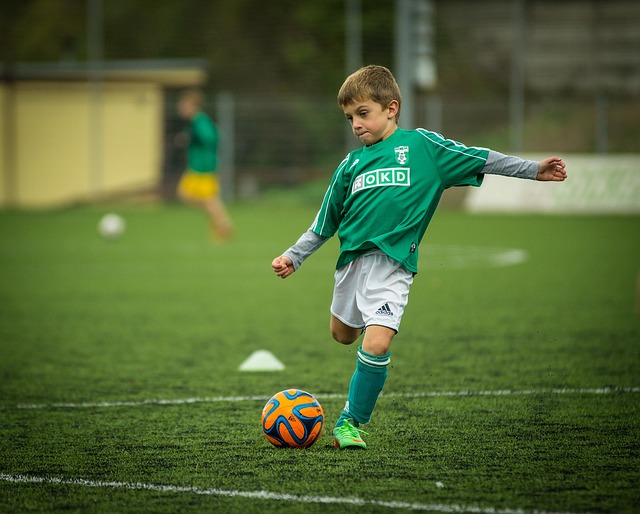Discover the secret strategy used by soccer players that’s a hot topic of debate: simulation. Is it a crafty tactic or simply foul play?
Contents
- 1. Understanding Simulation in Soccer: An Exploration of Gamesmanship and Its Impact on the Game
- 2. Examining the Controversial Art of Simulation: Unpacking Tactical Deception and Player Behavior
- 3. Identifying Simulation: Recognizing Key Telltale Signs and Distinguishing It from Skillful Play
- 4. The Problematic Consequences of Simulation: How It Harms the Integrity and Fairness of Soccer
- 5. The Role of Referees in Tackling Simulation: The Need for Consistent and Vigilant Officiating
- 6. Strategies for Minimizing Simulation: Promoting Fair Play and Ethical Behavior on the Pitch
- 7. Educating Players, Coaches, and Fans: Raising Awareness and Enhancing Understanding of the Impact of Simulation
- 8. Technology’s Role in Combating Simulation: VAR and Innovations Aimed at Eliminating Deception
- 9. Balancing Deterrence and Penalization: Fines, Suspensions, and Other Measures to Address Simulation
- 10. Cultivating a Culture of Integrity in Soccer: Building Stronger Ethics and Sportsmanship through Collective Efforts
1. Understanding Simulation in Soccer: An Exploration of Gamesmanship and Its Impact on the Game
Soccer is known for its fast-paced, physically demanding nature. Players often go to great lengths to gain an advantage over their opponents, and one tactic that has gained considerable attention is simulation, or what is commonly referred to as “diving.” This controversial practice is perceived as gamesmanship by some, while others view it as blatant foul play. In this post, we will delve into the intricate world of simulation in soccer and analyze its impact on the beautiful game.
Simulation, at its core, refers to the act of intentionally deceiving the referee by pretending to have been fouled or injured. It involves players exaggeratedly falling to the ground, clutching body parts, and writhing in apparent agony. Some argue that this strategy is a legitimate part of the game, a skill that players use to draw fouls or penalties. On the other hand, critics deem simulation as unsportsmanlike conduct, aimed at manipulating referees and unfairly influencing the outcome of a match.
- Impact on the game: Simulation can have a significant impact on the outcome of a match. A well-executed dive can result in a favorable decision from the referee, leading to free kicks, penalties, or even the dismissal of an opposing player. This can potentially swing the momentum of a game and change its entire course.
- Ethical considerations: The ethics behind simulation in soccer are a constant point of debate. While some argue that it is part of the game and should be accepted as a strategic move, others believe that it undermines the integrity of the sport. The constant quest for fairness and honesty in soccer makes the practice of simulation a highly contentious issue.

2. Examining the Controversial Art of Simulation: Unpacking Tactical Deception and Player Behavior
Simulation in soccer has long been a topic of debate and controversy, raising questions about the ethics and sportsmanship of players who engage in deceptive tactics on the field. This post aims to delve into the art of simulation, examining the fine line between gamesmanship and foul play.
One aspect to consider is the intention behind simulation. While some argue that it is a legitimate strategy aimed at gaining an advantage for the team, others view it as a betrayal of the sport’s principles. Simulation involves a player intentionally deceiving the referee by feigning a foul or injury, often exaggerating contact or diving without any contact at all.
There are several reasons why players may resort to simulation in soccer:
- Influencing referee decisions: Players may simulate fouls to encourage the referee to award their team a free kick, penalty, or card against their opponents.
- Time-wasting: Simulation can serve as a means to waste precious time, especially when a team is leading and looking to protect their advantage.
- Psychological impact: By simulating fouls, players may attempt to manipulate the emotions and focus of their opponents, frustrating them and potentially affecting their performance.
However, simulation is not without consequences. Many argue that it undermines the integrity of the game, diminishes fair play, and fosters a culture of dishonesty. To address this issue, governing bodies and leagues have implemented stricter rules and sanctions, aiming to deter players from engaging in such deceptive behavior.
Ultimately, the examination of simulation in soccer raises important questions about the ethical boundaries and responsibilities of players, the role of referees in detecting and penalizing such behavior, and the impact it has on the sport as a whole. By fostering discussion and promoting fair play, soccer can continue to evolve and uphold the values that make it a beloved worldwide phenomenon.
3. Identifying Simulation: Recognizing Key Telltale Signs and Distinguishing It from Skillful Play
Simulation in soccer, or the act of deceiving the referee or opponents into believing a foul or contact has occurred, is a contentious topic that often sparks heated debates among fans, players, and officials alike. In order to better understand the concept of simulation, it is crucial to recognize the key telltale signs that distinguish it from skillful play.
One of the most obvious signs of simulation is exaggerated or theatrical movements. Players who simulate often flail their limbs dramatically, throw themselves to the ground, or roll around in apparent agony, hoping to convince the referee of a foul. Additionally, simulation is often accompanied by a lack of contact or minimal contact with the opposing player. While a foul may occur without heavy contact, it is important to differentiate between genuine attempts to deceive and incidental contact during the course of play.
Another indicator of simulation is an inconsistent reaction to contact. A player who truly suffers a foul is likely to react similarly in different situations, whereas a player who simulates often has exaggerated and inconsistent reactions to contact. These subtle cues can help referees and spectators identify simulation and ensure fair play on the field.

4. The Problematic Consequences of Simulation: How It Harms the Integrity and Fairness of Soccer
In the world of soccer, few things are as divisive as the issue of simulation. Some consider it a clever tactic, a form of gamesmanship that can give players the advantage they need. Others see it as nothing more than foul play, a blatant attempt to deceive officials and gain an unfair advantage. Regardless of where you stand on the matter, there is no denying the problematic consequences that simulation can have on the integrity and fairness of the game.
Firstly, simulation undermines the integrity of soccer by eroding the trust between players, coaches, and officials. When a player dives or exaggerates contact in order to fool the referee, it creates an atmosphere of dishonesty and cynicism. This behavior spreads like wildfire, encouraging other players to adopt similar tactics to gain an edge. As a result, the game devolves into a flurry of theatrics and manipulation, rather than a display of skill and sportsmanship. The very essence of fair competition is compromised.
- Loss of credibility: Simulation erodes the credibility of the players involved and tarnishes the reputation of the sport as a whole.
- Unfair advantages: By simulating fouls or injuries, players can gain an unfair advantage by deceiving officials and influencing the outcome of the game.
- Negative impact on fans: Simulation frustrates fans who want to see a fair and genuine display of skill, leading to disillusionment and a loss of interest in the sport.
In conclusion, simulation in soccer raises ethical questions and poses a threat to the integrity and fairness of the game. It has the potential to undermine trust, create unfair advantages, and disenchant fans. It is imperative for the governing bodies of soccer to take a strong stance against simulation and implement strict measures to discourage this damaging practice. Only then can we restore the purity and authenticity of the beautiful game we all love.

5. The Role of Referees in Tackling Simulation: The Need for Consistent and Vigilant Officiating
Soccer is a sport known for its passion, skill, and occasional controversies. One such controversy is the issue of simulation, commonly referred to as diving or embellishment. Some consider simulation as part of the gamesmanship, an attempt to gain an advantage through tactical deception. However, others view it as foul play, an action that undermines the integrity of the game. This post will explore the role of referees in tackling simulation and emphasize the need for consistent and vigilant officiating.
The responsibility of referees in addressing simulation cannot be underestimated. They play a crucial role in maintaining the fair play and spirit of the game. Referees must be consistent in their decision-making and vigilant in identifying acts of simulation. A consistent approach means that referees should apply the same standards to all players, regardless of reputation or status. It ensures fairness and prevents any accusations of biased officiating. By being watchful and alert, referees can weed out simulation attempts effectively, sending a clear message that such behavior will not be tolerated.

6. Strategies for Minimizing Simulation: Promoting Fair Play and Ethical Behavior on the Pitch
When it comes to simulation in soccer, also known as diving or feigning injury, opinions are often divided. Some see it as a clever tactic, a form of gamesmanship that can give their team an advantage. Others, however, consider it to be foul play, a dishonest act that undermines the integrity of the game. Regardless of where you stand on the issue, it is important to acknowledge that simulation can have a negative impact on fair play and ethical behavior on the pitch.
One strategy for minimizing simulation is to promote a culture of honesty and sportsmanship within teams. Coaches can emphasize the importance of fair play and discourage their players from engaging in deceptive practices. By instilling a sense of responsibility and ethical behavior in their players, coaches can help create an environment where simulation is frowned upon.
- Encourage players to take responsibility for their actions on the pitch.
- Teach players to show respect towards opponents and referees.
- Highlight the negative consequences of simulation, such as damaging the reputation of the team or player.
- Promote positive role models who demonstrate fair play in soccer.
Another strategy is to ensure that referees are equipped to detect and penalize simulation effectively. Referees play a crucial role in maintaining the fairness and integrity of the game, and it is essential that they have the necessary knowledge and tools to identify simulation when it occurs. Training programs could be implemented to improve referee decision-making in relation to simulation, including:
- Teaching referees to look for specific signs of simulation, such as exaggerated falls or immediate recovery.
- Providing referees with video replays and technology to assist in making accurate decisions.
- Implementing stricter disciplinary measures for players found guilty of simulation, such as fines or suspensions.
- Encouraging referees to communicate with each other to ensure consistency in decision-making.
7. Educating Players, Coaches, and Fans: Raising Awareness and Enhancing Understanding of the Impact of Simulation
Simulation, also known as diving or embellishment, has become a hot topic in the world of soccer. It refers to players deliberately deceiving the referee by feigning injury or exaggerating contact to gain an unfair advantage. While some argue that it is an integral part of the game, a strategic tactic to win penalties or free kicks, others condemn it as a form of unsportsmanlike behavior. The debate surrounding simulation is complex, and raising awareness about its impact is crucial in understanding its implications on the sport.
One of the key reasons to educate players, coaches, and fans about simulation is to foster a fair and respectful playing environment. By shedding light on the consequences of simulation, including the potential for players to be penalized or suspended, the aim is to discourage such behavior. It is important for everyone involved in the game to recognize that simulation not only undermines the integrity of the sport but also sets a poor example for young aspiring athletes. Increasing understanding about the negative effects of simulation can help maintain the spirit of fair play and ensure that soccer remains a game of skill, strategy, and genuine competition.
- Simulation can lead to a loss of trust between players and officials, damaging the overall credibility of the game.
- Over time, excessive simulation can taint the perception of soccer, causing fans to lose interest or question the authenticity of the performances.
- By educating players and coaches about the impact of simulation, it becomes possible to shift the focus towards developing genuine techniques and skills that enhance the beauty of the game.
Ultimately, the goal of raising awareness and enhancing understanding of simulation is to foster a culture of sportsmanship and promote fair competition. By educating players, coaches, and fans about the impacts of simulation, we can strive to eliminate this controversial aspect from the game and ensure that soccer remains a sport driven by talent, teamwork, and mutual respect.

8. Technology’s Role in Combating Simulation: VAR and Innovations Aimed at Eliminating Deception
Technology has become an integral part of the game of soccer, not only in enhancing the viewing experience but also in combating simulation and deception on the field. Video Assistant Referee (VAR) is one of the most significant innovations that have revolutionized the sport. By utilizing video technology during matches, VAR allows referees to review and make more accurate decisions, reducing the impact of simulation and diving.
VAR operates by using cameras positioned around the stadium to capture different angles of incidents. The referee can then review the footage on a monitor at the side of the pitch or receive information from the VAR team who have identified potential situations requiring review. This technology has played a crucial role in eliminating deceptive tactics from the game, such as players exaggerating falls or trying to fool the referee into awarding a foul or penalty. With VAR, referees have access to clear and unbiased evidence, enabling them to make fairer decisions and maintain the integrity of the game.
In addition to VAR, other innovative technologies have emerged to further combat simulation in soccer. Smart jerseys and body sensors are being developed to monitor players’ movements and detect any sudden changes in velocity or impact, providing valuable data for referees to assess the authenticity of a fall or injury. Furthermore, advancements in artificial intelligence are being explored to develop algorithms that can analyze players’ actions and behaviors in real-time, distinguishing between genuine falls and acts of deception. These technologies are aimed at creating a level playing field, promoting fair competition, and deterring players from attempting simulation or foul play.
Overall, technology has undoubtedly played a vital role in combating simulation and deception in soccer. With innovations like VAR and the potential developments in smart jerseys and AI analysis, the sport is steadily evolving towards a more transparent and fair environment. These advancements not only ensure a more enjoyable experience for fans but also uphold the principles of fair play and sportsmanship that lie at the heart of the beautiful game.
9. Balancing Deterrence and Penalization: Fines, Suspensions, and Other Measures to Address Simulation
When it comes to simulation, or diving, in soccer, there is an ongoing debate about how to effectively penalize players without discouraging legitimate fouls. Balancing deterrence and penalization requires a careful consideration of fines, suspensions, and other measures that can address this issue within the sport.
Fines: One way to deter simulation in soccer is by imposing fines on players who are found guilty of diving. These fines can act as a financial deterrent, hitting players where it hurts the most – their wallets. The severity of the fine could vary depending on the level of simulation and the player’s history of offenses. By implementing fines, soccer authorities can send a strong message that simulation will not be tolerated, while also being mindful of the need to maintain the flow of the game and not overly disrupt the match.

10. Cultivating a Culture of Integrity in Soccer: Building Stronger Ethics and Sportsmanship through Collective Efforts
In the world of soccer, the issue of simulation has long been a controversial topic. Simulation, also known as diving or embellishment, is when a player intentionally deceives the referee by exaggerating contact or pretending to be fouled. While some argue that simulation is just a part of the game, a strategic way to gain an advantage, others view it as a form of cheating that undermines the integrity of the sport.
There are several reasons why simulation is considered problematic in soccer:
- Faking injuries: Players who simulate fouls often pretend to be injured, causing unnecessary stoppages in play and disrupting the flow of the game.
- Unfair advantage: Simulation can deceive referees into making incorrect decisions, such as awarding penalties or issuing yellow or red cards. This can have a significant impact on the outcome of a match.
- Undermining sportsmanship: Soccer is built on principles of fair play, respect, and sportsmanship. Simulation goes against these principles, creating a culture of dishonesty and gamesmanship.
- Deteriorating reputation: The prevalence of simulation in soccer can tarnish the reputation of the sport, with critics suggesting that it promotes a culture of cheating.
While efforts have been made to combat simulation, such as the introduction of Video Assistant Referee (VAR) technology, it remains a challenge to completely eradicate this questionable practice from the game. The responsibility lies not only with players, but also with coaches, referees, and governing bodies. It is vital that all stakeholders work collectively to cultivate a culture of integrity in soccer, promoting fair play, honesty, and transparency on and off the field.

In conclusion, simulation in soccer is a contentious topic that sparks debates. While some perceive it as gamesmanship, others consider it foul play. It’s crucial for players, referees, and fans to understand its impact on the game. Finding a balance between fair play and strategic advantage is key.


